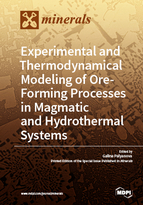Experimental and Thermodynamical Modeling of Ore-Forming Processes in Magmatic and Hydrothermal Systems
A special issue of Minerals (ISSN 2075-163X).
Deadline for manuscript submissions: closed (30 June 2018) | Viewed by 52002
Special Issue Editor
2. Department of Geology and Geophysics, Novosibirsk State University, 630090 Novosibirsk, Russia
Interests: ore-forming processes; experiment; thermodynamic modeling; minerals-indicators; fluid−mineral−rock interactions; gold mineralization; gold deposits; mechanisms of ore formation; reconstruction of T,P,X-conditions
Special Issues, Collections and Topics in MDPI journals
Special Issue Information
Dear Colleagues,
Experimental investigations and thermodynamical modeling have been successfully used to solve many problems, in which ore-forming processes play an important role. Experimental study of simple systems with precisely controlled parameters provides data necessary for obtaining reliable thermodynamic characteristics of minerals, aqueous species (ions and complex ions and molecules), gas mixtures and solid solutions. The main obstacles to the experiments are multi-component, multi-phase and multi-aggregate features of natural systems and the inevitability of their simplification. Thermodynamic modeling can be an alternative to complex model experiments. To construct quantitative genetic models of ore formation processes, computer thermodynamic modeling on the basis of modern program complexes is used. The reconstruction of the sources of ore components and fluids, physico-chemical parameters, mechanisms of accumulation and separation of elements during the formation of ore deposits is an important task of fundamental problems of ore-forming processes. We invite researchers to contribute to the Special Issue on the experimental investigations and thermodynamical modeling of ore-forming processes in magmatic and hydrothermal systems.
Dr. Galina Palyanova
Guest Editor
Manuscript Submission Information
Manuscripts should be submitted online at www.mdpi.com by registering and logging in to this website. Once you are registered, click here to go to the submission form. Manuscripts can be submitted until the deadline. All submissions that pass pre-check are peer-reviewed. Accepted papers will be published continuously in the journal (as soon as accepted) and will be listed together on the special issue website. Research articles, review articles as well as short communications are invited. For planned papers, a title and short abstract (about 100 words) can be sent to the Editorial Office for announcement on this website.
Submitted manuscripts should not have been published previously, nor be under consideration for publication elsewhere (except conference proceedings papers). All manuscripts are thoroughly refereed through a single-blind peer-review process. A guide for authors and other relevant information for submission of manuscripts is available on the Instructions for Authors page. Minerals is an international peer-reviewed open access monthly journal published by MDPI.
Please visit the Instructions for Authors page before submitting a manuscript. The Article Processing Charge (APC) for publication in this open access journal is 2400 CHF (Swiss Francs). Submitted papers should be well formatted and use good English. Authors may use MDPI's English editing service prior to publication or during author revisions.
Keywords
- The source and chemistry of ore fluids
- Geofluid-rock interaction
- Solubilities of ore minerals
- Transport of the metals
- Models of ore formation
- Mechanisms of ore formation
- Mineral equilibria
- Nonequilibrium processes
- Reconstruction of T,P,X-conditions






